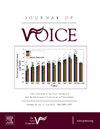心理健康和语音障碍的交叉:一个范围综述
IF 2.4
4区 医学
Q1 AUDIOLOGY & SPEECH-LANGUAGE PATHOLOGY
引用次数: 0
摘要
目的以往的研究表明,语音障碍经常与心理健康障碍共存,这可能会影响语音治疗的寻求行为和效果。我们的目标是描述现有的关于声音障碍和心理健康之间关系的文献,并调查与心理健康和声音障碍诊断相关的细微差别。数据来源:MEDLINE, ProQuest, PsycINFO和Web of Science。采用PRISMA方案,进行范围审查。检索的数据库包括:Ovid MEDLINE、ProQuest PsycINFO和Web of Science。我们的纳入标准是所有在门诊就诊的声音和精神健康障碍的成年人,排除那些既往有头颈部手术、癌症、放射、或发育异常和某些精神健康障碍病史的人。结果由两个独立筛选者筛选纳入。然后对数据进行提取和分析,以呈现主要发现和特征。结果共纳入156篇论文,发表时间从1938年到2021年,其中女性和教师是描述最多的人群。最常见的喉部疾病是发音困难(n = 107, 68.6%)、球形(n = 33, 21.2%)和伴有球形的发音困难(n = 16, 10.2%)。在纳入的研究中发现的两种最常见的精神健康障碍是焦虑症(n = 123, 78.8%)和心境障碍(n = 111, 71.2%)。声音障碍指数是收集声音障碍数据最常用的工具(n = 36, 23.1%),而医院焦虑和抑郁量表是收集精神健康障碍数据最常用的工具(n = 20, 12.8%)。在纳入的文章中研究的人群主要是从事教育职业的女性。在纳入的文献中,种族和民族仅占10.2% (n = 16),最常见的研究种族是白人/高加索人(n = 13, 8.3%)。结论:我们对当前关于心理健康和声音障碍的文献进行了范围审查,揭示了这两种疾病之间的交叉。目前的文献代表了随着时间的推移,在术语方面的变化,认识到病人的精神健康和喉部状况的个性化经验。然而,在研究的患者群体中,在种族和性别方面仍然存在很大的同质性,其模式和差距需要进一步调查。本文章由计算机程序翻译,如有差异,请以英文原文为准。
Intersection of Mental Health and Dysphonia: A Scoping Review
Objective
Previous research has indicated that voice disorders frequently co-occur with mental health disorders, which may influence voice treatment seeking behavior and effectiveness. Our goal is to characterize the existing literature on the relationship between voice disorders and mental health and to investigate nuances related to mental health and voice disorder diagnosis.
Data Sources
Ovid MEDLINE, ProQuest PsycINFO, and Web of Science.
Review Methods
Using the PRISMA protocol, a scoping review was performed. Databases searched included: Ovid MEDLINE, ProQuest PsycINFO, and Web of Science. Our inclusion criteria were all adults seen in an outpatient setting for voice and mental health disorders, excluding those with a prior history of head and neck surgery, cancers, radiation, or developmental anomalies, and certain mental health disorders. Results were screened by two independent screeners for inclusion. Data were then extracted and analyzed to present key findings and characteristics.
Results
A total of 156 articles, with publication dates ranging from 1938 to 2021, were included in the analysis, with females and teachers being the most described population groups. The most frequently studied laryngeal disorders were dysphonia (n = 107, 68.6%), globus (n = 33, 21.2%), and dysphonia with globus (n = 16, 10.2%). The two most common mental health disorders found in the included studies were anxiety disorders (n = 123, 78.8%) and mood disorders (n = 111, 71.2%). The Voice Handicap Index was the most used tool to gather data on voice disorders (n = 36, 23.1%), while the Hospital Anxiety and Depression Scale was the most used tool to gather data on mental health disorders (n = 20, 12.8%). The populations studied within the included articles were predominately female and worked in educational occupations. Race and ethnicity was only reported for 10.2% of included articles (n = 16) and the most commonly studied race was White/Caucasian (n = 13, 8.3%).
Conclusion
Our scoping review of the current literature on mental health and voice disorders reveals an intersection between the conditions. The current literature represents change over time in terms of terminology that recognizes the patient's individualized experience of mental health and laryngeal conditions. However, there is still a great deal of homogeneity in the studied patient populations in terms of race and gender, with patterns and gaps that require further investigation.
求助全文
通过发布文献求助,成功后即可免费获取论文全文。
去求助
来源期刊

Journal of Voice
医学-耳鼻喉科学
CiteScore
4.00
自引率
13.60%
发文量
395
审稿时长
59 days
期刊介绍:
The Journal of Voice is widely regarded as the world''s premiere journal for voice medicine and research. This peer-reviewed publication is listed in Index Medicus and is indexed by the Institute for Scientific Information. The journal contains articles written by experts throughout the world on all topics in voice sciences, voice medicine and surgery, and speech-language pathologists'' management of voice-related problems. The journal includes clinical articles, clinical research, and laboratory research. Members of the Foundation receive the journal as a benefit of membership.
 求助内容:
求助内容: 应助结果提醒方式:
应助结果提醒方式:


